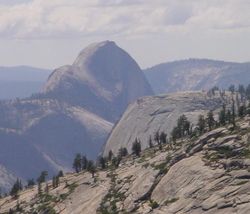Batholith
2008/9 Schools Wikipedia Selection. Related subjects: Geology and geophysics
A batholith (from Greek bathos, depth + lithos, rock) is a large emplacement of igneous intrusive (also called plutonic) rock that forms from cooled magma deep in the Earth's crust. Batholiths are almost always made mostly of felsic or intermediate rock-types, such as granite, quartz monzonite, or diorite (see also granite dome).
Although they may appear uniform, batholiths are in fact structures with complex histories and compositions. They are composed of multiple masses, or plutons, bodies of igneous rock of irregular dimensions (typically at least several kilometers) that can be distinguished from adjacent igneous rock by some combination of criteria including age, composition, texture, or mappable structures. Individual plutons are crystallized from magma that traveled toward the surface from a zone of partial melting near the base of the Earth's crust.
Traditionally, these plutons have been considered to form by ascent of relatively buoyant magma in large masses called plutonic diapirs. Because the diapirs are liquefied and very hot, they tend to rise through the surrounding country rock, pushing it aside and partially melting it. Most diapirs do not reach the surface to form volcanoes, but instead slow down, cool and usually solidify 5 to 30 kilometers underground as plutons (hence the use of the word pluton; in reference to the Roman god of the underworld Pluto). It has also been proposed that plutons commonly are formed not by diapiric ascent of large magma diapirs, but rather by aggregation of smaller volumes of magma that ascended as dikes.
A batholith is formed when many plutons converge together to form a huge expanse of granitic rock. Some batholiths are mammoth, paralleling past and present subduction zones and other heat sources for hundreds of kilometers in continental crust. One such batholith is the Sierra Nevada Batholith, which is a continuous granitic formation that forms much of the Sierra Nevada in California. An even larger batholith, found predominantly in the Coast Mountains of western Canada, extends for 1,800 kilometers and reaches into southeastern Alaska, which is called the Coast Plutonic Complex.
There is also an important geographic usage of the term batholith. For a geographer, a batholith is an exposed area of mostly continuous plutonic rock that covers an area larger than 100 square kilometers. Areas smaller than 100 kilometers are called stocks. However, the majority of batholiths visible at the surface (via outcroppings) have areas far greater than 100 square kilometers. These areas are exposed to the surface through the process of erosion accelerated by continental uplift acting over many tens of millions to hundreds of millions of years. This process has removed several tens of kilometers of overlying rock in many areas, exposing the once deeply buried batholiths.
Batholiths exposed at the surface are also subjected to huge pressure differences between their former homes deep in the earth and their new homes at or near the surface. As a result, their crystal structure expands slightly and over time. This manifests itself by a form of mass wasting called exfoliation. This form of erosion causes convex and relatively thin sheets of rock to slough off the exposed surfaces of batholiths (a process accelerated by frost wedging). The result is fairly clean and rounded rock faces. A well-known example of the result of this process is Half Dome, which located in Yosemite Valley.
